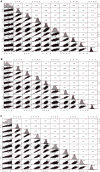Impact of DNA-Methylation Age Acceleration on Long-Term Mortality Among US Adults With Cardiovascular-Kidney-Metabolic Syndrome
- PMID: 40118808
- PMCID: PMC12132836
- DOI: 10.1161/JAHA.124.039751
Impact of DNA-Methylation Age Acceleration on Long-Term Mortality Among US Adults With Cardiovascular-Kidney-Metabolic Syndrome
Abstract
Background: The association between DNA methylation age acceleration (DNAmAA) and cardiovascular-kidney-metabolic (CKM) syndrome stages and long-term mortality in the population with CKM syndrome remains unclear.
Methods and results: This cohort study included 1889 participants from the National Health and Nutrition Examination Survey (1999-2002) with CKM stages and DNA methylation age data. DNAmAA was calculated as residuals from the regression of DNA methylation age on chronological age. The primary outcome was all-cause mortality, with cardiovascular and noncardiovascular mortality as secondary outcomes. Proportional odds models assessed the associations between DNAmAAs and CKM stages, and Cox proportional hazards regression models estimated the associations between DNAmAAs and mortality. Significant associations were found between DNAmAAs and advanced CKM stages, particularly for GrimAge2Mort acceleration (GrimAA) (odds ratio [OR], 1.547 [95% CI, 1.316-1.819]). Over an average follow-up of 14 years, 1015 deaths occurred. Each 5-unit increase in GrimAA was associated with a 50% increase in all-cause mortality (95% CI, 1.39-1.63), a 77% increase in cardiovascular mortality (95% CI, 1.46-2.15), and a 42% increase in noncardiovascular mortality (95% CI, 1.27-1.59). With the lowest GrimAA tertile as a reference, the highest GrimAA tertile showed hazard ratios of 1.95 (95% CI, 1.56-2.45) for all-cause mortality, 3.06 (95% CI, 2.13-4.40) for cardiovascular mortality, and 1.65 (95% CI, 1.20-2.29) for noncardiovascular mortality. Mediation analysis indicated that GrimAA mediates the association between various exposures (including physical activity, Healthy Eating Index-2015 score, hemoglobin A1c, etc.) and mortality.
Conclusions: GrimAA may serve as a valuable biomarker for assessing CKM stages and mortality risk in individuals with CKM syndrome, thereby informing personalized management strategies.
Keywords: DNA‐methylation age; DNA‐methylation age acceleration; GrimAge2Mort; cardiovascular‐kidney‐metabolic; mortality.
Conflict of interest statement
None.
Figures





References
-
- Ndumele CE, Neeland IJ, Tuttle KR, Chow SL, Mathew RO, Khan SS, Coresh J, Baker‐Smith CM, Carnethon MR, Després JP, et al. A synopsis of the evidence for the science and clinical Management of cardiovascular‐kidney‐metabolic (CKM) syndrome: a scientific statement from the American Heart Association. Circulation. 2023;148:1636–1664. doi: 10.1161/CIR.0000000000001186 - DOI - PubMed
-
- Ndumele CE, Rangaswami J, Chow SL, Neeland IJ, Tuttle KR, Khan SS, Coresh J, Mathew RO, Baker‐Smith CM, Carnethon MR, et al. Cardiovascular‐kidney‐metabolic health: a presidential advisory from the American Heart Association. Circulation. 2023;148:1606–1635. doi: 10.1161/CIR.0000000000001184 - DOI - PubMed
MeSH terms
LinkOut - more resources
Full Text Sources
Medical
Miscellaneous

